1993 BUICK LESABRE inflation pressure
[x] Cancel search: inflation pressurePage 229 of 324
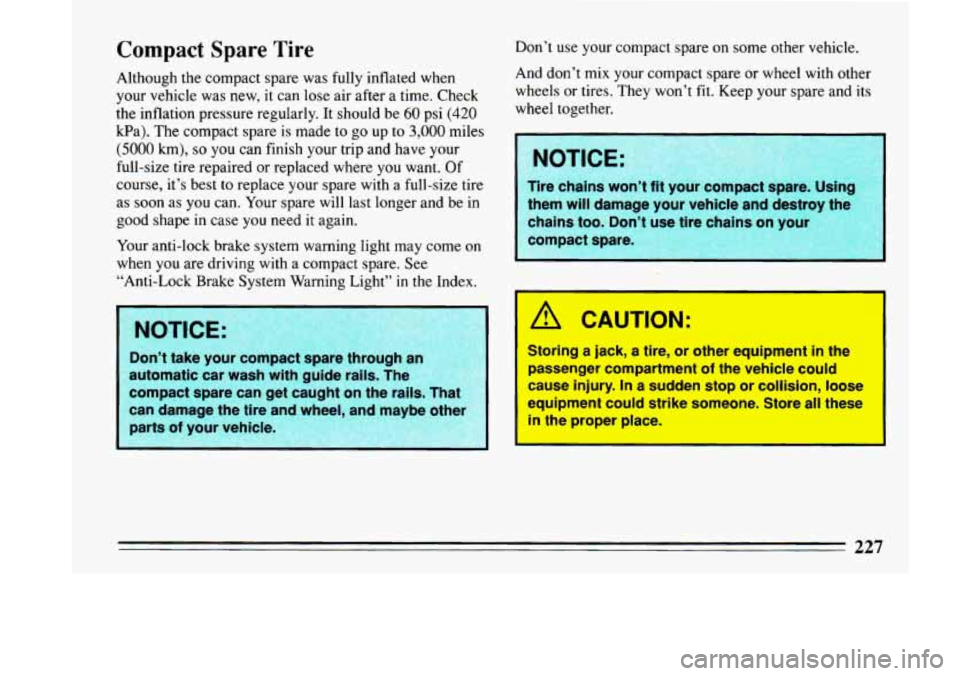
Compact Spare Tire
Although the compact spare was fully inflated when
your vehicle was new, it can lose air after a time. Check
the inflation pressure regularly. It should be
60 psi (420
Wa). The compact spare is made to go up to 3,000 miles
(5000 km), so you can finish your trip and have your
full-size tire repaired or replaced where you want. Of
course, it’s best
to replace your spare with a full-size tire
as soon as
you can. Your spare will last longer and be in
good shape in case you need it again.
Your anti-lock brake system warning light may come
on
when you are driving with a compact spare. See
“Anti-Lock Brake System Warning Light” in the Index. Don’t
use your
compact spare on some other vehicle.
And don’t mix your compact spare or wheel with other
wheels or tires. They won’t fit. Keep your spare and its
wheel together.
Tire chains wo
them will damage
y
chains too. Do
compact spar I
A CnUTION:
Storing a jack, a tire, or other equipment in the
passenger compartment of the vehicle could
cause injury. In a sudden stop or colllsian, loose
mwipment could strike someone. Store all these
.__ the proper place.
I
227
Page 255 of 324
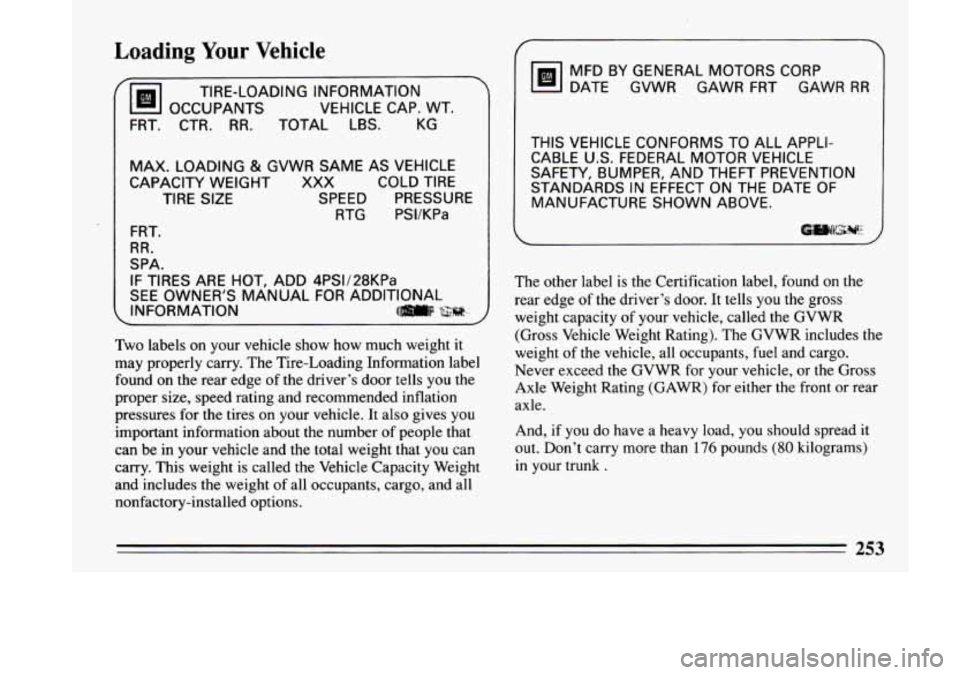
Loading Your Vehicle
TIRE-LOADING INFORMATION
OCCUPANTS VEHICLE CAP. WT.
FRT. CTR. RR. TOTAL LBS. KG
MAX. LOADING
& GVWR SAME AS VEHICLE
CAPACITY WEIGHT XXX COLD TIRE
TIRE SIZE SPEED PRESSURE RTG PSVKPa
FRT.
RR.
SPA.
IF TIRES ARE HOT, ADD 4PSV28KPa
SEE OWNER’S MANUAL FOR ADDITIONAL
, INFORMATION
Two labels on your vehicle show how much weight it
may properly carry. The Tire-Loading Information label
found on the rear edge of the driver’s door tells you the
proper size, speed rating and recommended inflation
pressures for the tires on your vehicle. It also gives you
important information about the number of people that
can be in your vehicle and the total weight that you can
carry. This weight is called the Vehicle Capacity Weight
and includes the weight of all occupants, cargo, and all
nonfactory-installed options.
MFD BY GENERAL MOTORS CORP
DATE GVWR GAWR FRT GAWR
RR
THIS VEHICLE CONFORMS TO ALL APPLI-
CABLE U.S. FEDERAL MOTOR VEHICLE
SAFETY, BUMPER, AND THEFT PREVENTION
STANDARDS IN EFFECT ON THE DATE
OF
MANUFACTURE SHOWN ABOVE.
The other label is the Certification label, found on the
rear edge of the driver’s door. It tells you the gross
weight capacity of your vehicle, called the GVWR
(Gross Vehicle Weight Rating). The GVWR includes the
weight of the vehicle, all occupants, fuel and cargo.
Never exceed the GVWR for your vehicle, or the Gross
Axle Weight Rating (GAWR) for either the front or rear
axle.
And,
if you do have a heavy load, you should spread it
out. Don’t carry more than
176 pounds (80 kilograms)
in your trunk .
Page 258 of 324

Inflation - Tire Pressure
The Tire-Loading Information label which is on the rear
edge of the driver’s door shows the correct inflation
pressures for your tires, when they’re cold. “Cold”
means your vehicle has been sitting for at least
three
hours or driven no more than a mile.
When to Check: Check your tires once a month or
more.
Don’t forget your compact spare tire.
It should be at 60
psi (420 Pa).
How to Check: Use a good quality pocket-type gage to
check tire pressure. Simply looking at the tires will not
tell you the pressure, especially if you have radial tires
--
which may look properly inflated even if they’re
underinflated.
If your tires have valve caps, be sure to put them back on. They help prevent leaks by keeping out
dirt and
moisture.
256
I
Page 259 of 324
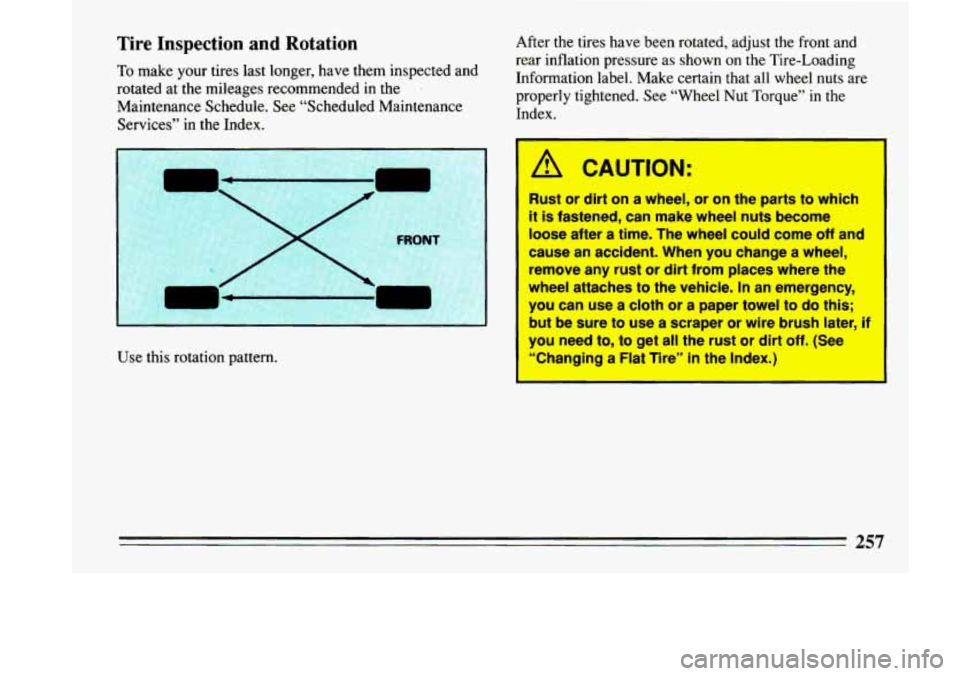
Tire Inspection and Rotation
To make your tires last longer, have them inspected and
rotated at the mileages recommended in the
.
Maintenance Schedule. See “Scheduled Maintenance
Services’’ in the Index.
Use this rotation pattern. After
the tires have been rotated, adjust the front and
rear inflation pressure as shown on the Tire-Loading
Information label. Make certain that all wheel nuts are
properly tightened. See “Wheel Nut Torque” in the
Index.
I
A CAUTION:
Rust or dlrt on a wheel, or on the parts to which
it is fastetfed, can make wheel nuts become
loose after a time. The wheel could come off and
cause
an accident. When you change a wheel,
remove any rust or dirt from places where the
wheel attaches
to the vehicle. In an emergency,
you can use a cloth or a paper towel to do this;
but be
sure to use a scraper or wire brush later, if
you need to, to get all the rust or dirt off. (See
“Changing a FI; Tire’* On the Index.)
Page 291 of 324
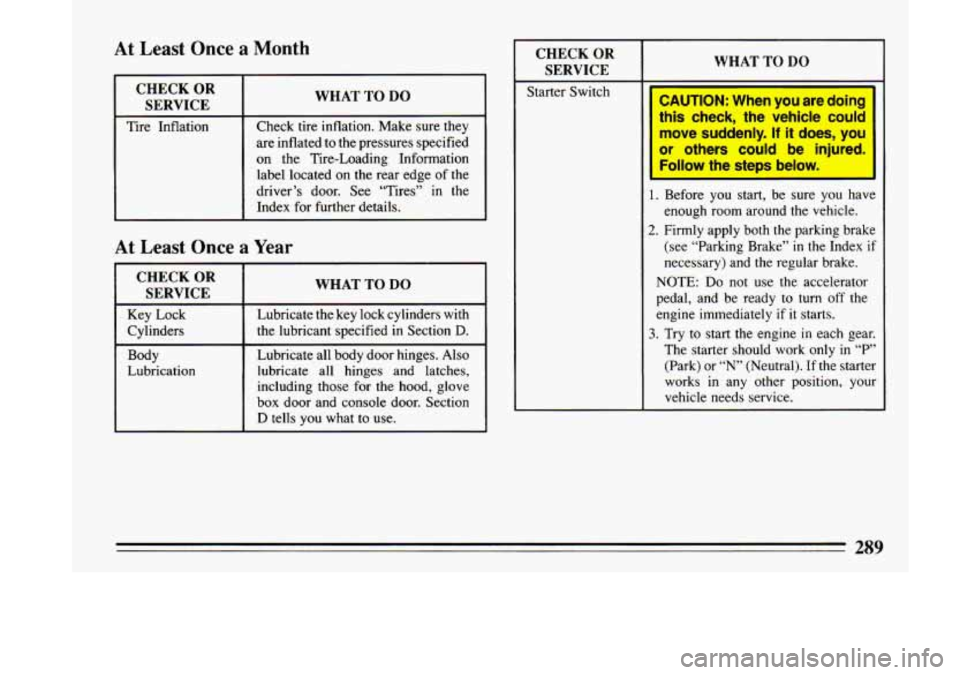
At Least Once a Month
1 CHECKOR SERVICE
I WHAT TO DO
~ ~~~
Tire Inflation Check tire inflation. Make sure
they
are inflated to the pressures specified
on the Tire-Loading Information label located on the rear edge of the
driver’s door. See “Tires”
in the
Index for further details.
At Least Once a Year
CHECK OR
SERVICE
Key Lock
Cylinders
Body
Lubrication
WHAT TO DO
Lubricate the key lock cylinders with
the lubricant specified in Section
D.
Lubricate all body door hinges. Also
lubricate all hinges and latches,
including those
for the hood, glove
box door and console door. Section
D tells you what to use.
CHECK OR
SERVICE
Starter Switch
L
WHAT TO DO
CAUTION: When you are doing
this check, the vehicle could move suddenly.
If it does, you
or others could be injured. Follow the steps below.
1. Before you start, be sure you have
enough room around
the vehicle.
2. Firmly apply both the parking brake
(see “Parking Brake” in
the Index if
necessary) and the regular brake.
NOTE:
Do not use the accelerator
pedal, and be ready to turn
off the
engine immediately
if it starts.
3. Try to start the engine in each gear.
The starter should work only
in “P’
(Park) or “N’ (Neutral). If the starter
works
in any other position, your
vehicle needs service.
Page 311 of 324
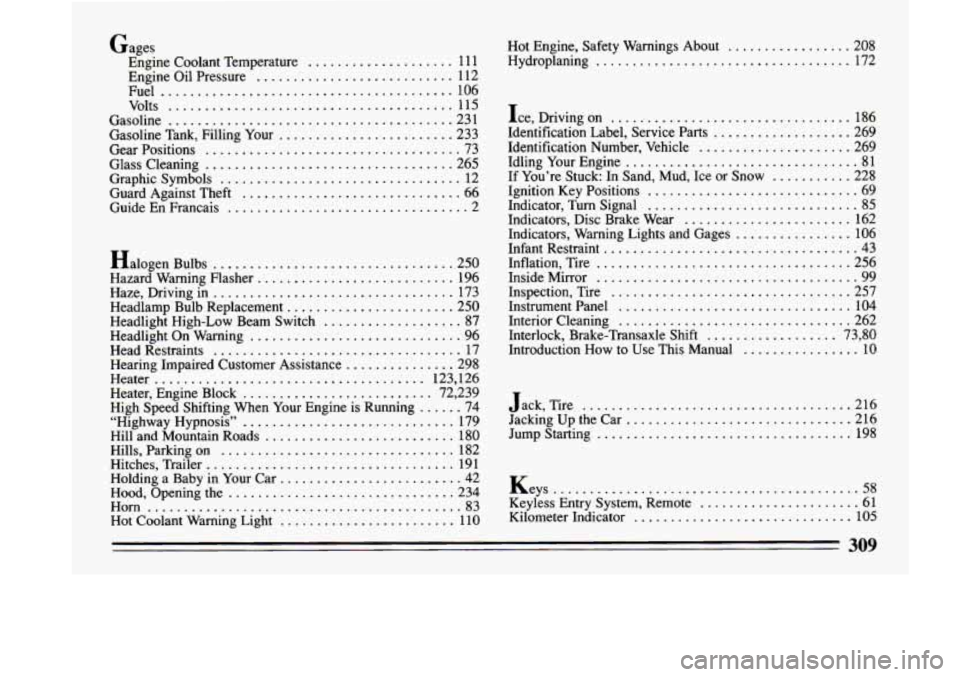
Gages Engine Coolant Temperature
.................... 11 1
Engine Oil Pressure
........................... 112
Fuel
........................................ 106
Volts
....................................... 115
Gasoline
....................................... 231
Gasoline Tank. Filling Your
........................ 233
Gear Positions
................................... 73
Glass Cleaning
.................................. 265
Graphic Symbols
................................. 12
Guard Against Theft
.............................. 66
Guide En Francais
................................. 2
I
H
H
H
H
H
H
H
H
H
H
“I
H
H
H
H
H
H
H
Ialogen Bulbs ................................. 250
[azard Warning Flasher
........................... 196
[aze. Driving in
................................. 173
[eadlamp Bulb Replacement
....................... 250
[eadlight On Warning
............................. 96
[ead Restraints
.................................. 17
[earing Impaired Customer Assistance
............... 298
[eater
..................................... 123. 126
.eater. Engine Block
.......................... 72. 239
Highway Hypnosis”
............................. 179
:ill and Mountain Roads
.......................... 180
ills. Parking on
................................ 182
.itches. Trailer
.................................. 191
:olding a Baby in Your Car
......................... 42
.ood. Opening the
............................... 234
:orn ........................................... 83
:ot Coolant Warning Light
........................ 110
[eadlight High-Low Beam Switch ................... 87
:igh Speed Shifting When Your Engine is Running
...... 74 Hot Engine. Safety Warnings About
................. 208
Hydroplaning ................................... 172
Ice. Driving
on ................................. 186
Identification Label. Service Parts
................... 269
Identification Number. Vehicle
..................... 269
Idling Your Engine
................................ 81
If You’re Stuck: In Sand. Mud. Ice or Snow
........... 228
Ignition Key Positions
............................ -69
Indicator.
Turn Signal ............................. 85
Indicators. Disc Brake Wear ....................... 162
Indicators. Warning Lights and Gages
................ 106
Infant Restraint
................................... 43
Inflation. Tire
................................... 256
Inside Mirror
.................................... 99
Inspection. Tire
................................. 257
Instrument Panel
................................ 104
Interior Cleaning
................................ 262
Interlock. Brake-Transaxle Shift
.................. 73. 80
Introduction How to Use This Manual ................ 10
..................................... J ack. Tire 216
Jacking Up the Car
.............................. -216
Jump Starting
................................... 198
Keys
.......................................... 58
Keyless Entry System. Remote
...................... 61
Kilometer Indicator
.............................. 105
309
.._ .. .